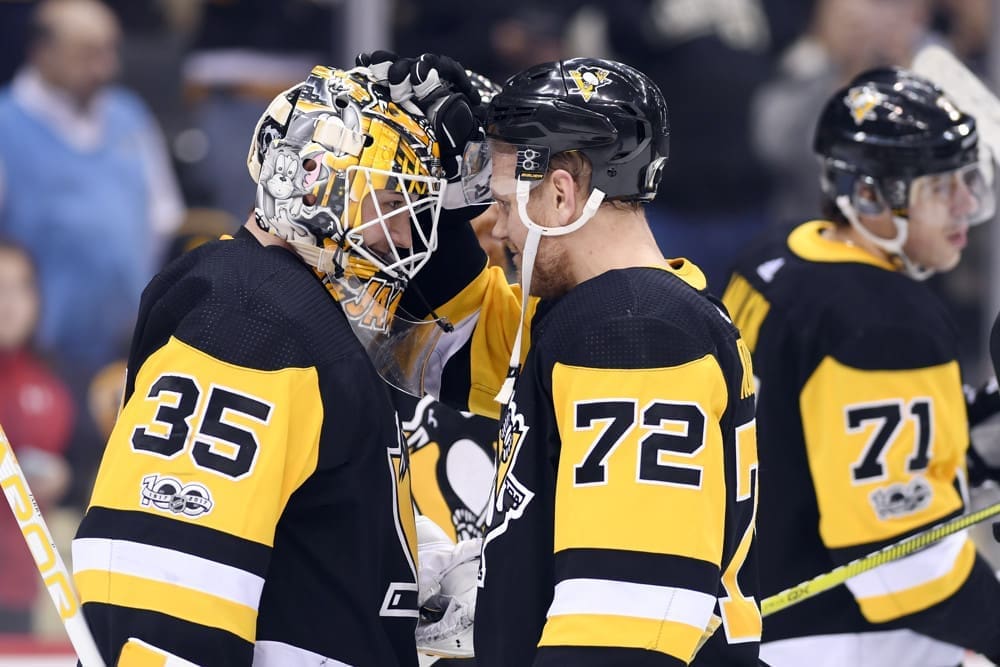Penguins
Gajtka: Penguins Make Right Call in Paying Patric Hörnqvist
There is only one Patric Hörnqvist. It’s become more and more evident as the season has progressed.

There is only one Patric Hörnqvist. It’s become more and more evident as the season has progressed: There is no meaningful replacement for Hörnqvist if the signed elsewhere this upcoming summer.
So, it didn’t come as a terrible shock when Jim Rutherford announced on an otherwise slow NHL trade deadline day for the Penguins that the team and Hörnqvist are close to a contract extension.
“Over my career, I’ve done very few contracts during the season,” Rutherford told reporters Monday at Lemieux Sports Complex in Cranberry. “This shows what the organization and I think of Patric to get it done sooner than later. I felt it was important that he knows and we know that he’s going to be here going forward.”
Multiple reports indicate the parameters are set: Five years at an average annual value (AAV) of $5.3 million. That’s about the low end of what Hörnqvist, 31, could’ve expected to make if he allowed unrestricted free agency to run its course in the offseason.
But he didn’t want that and neither did the Penguins. Plus, with the salary cap set to rise by at least $3 million next season, it’s much easier to imagine the Penguins squeezing Hörnqvist in without clearing too much underbrush. Getting Vegas to cover $2 million of Derick Brassard‘s salary next season helps, too.
Longevity Concerns?
The fact that Hörnqvist just returned from missing three weeks due to injury is ironic because the primary long-term concern with the right-handed winger is that his body will break down due to the wear he naturally incurs through his rambunctious style of play.
To classify that as a real risk is missing the point, though. With all apologies to rookie Zach Aston-Reese, there’s no one in the organization — or really in the entire league — who can infuse the mix of energy, enthusiasm, and underrated excellence Hörnqvist does in most aspects of the game.
Hörnqvist has missed 11 games this year, but his low for games played in a season is 64, in his first Penguins season of 2014-15. By comparison, Evgeni Malkin has played fewer than 64 games three times, including twice in the past four seasons. Not saying Malkin is brittle or that Hörnqvist will always be durable, but the latter has a track record of staying on the ice through his first 10 NHL seasons.
Hörnqvist’s availability has undoubtedly contributed to his almost metronomic consistency in the category of offensive production. In his past three seasons, his points-per-game average is 0.62, 0.63 and 0.63. What’s his career average? Why, it’s 0.63.
He’s also been a reliable possession player over his career, even this season when he’s only lifted the Penguins’ attempt ratio by 2 percent when on the ice, a metric also known as Corsi Relative. He’s been at 4 percent Corsi Relative or over in his first three Penguins seasons, so that trend bears watching, but Hörnqvist has still been helping more than hurting the Penguins wage the territorial battle.
Then there’s the net-front/slot role Hörnqvist serves on the power play. Per Josh Yohe at The Athletic, the man advantage has a crazy-big conversion split with and without the total Swedish eclipse in opposing creases:
Late night stat for you:
Penguins power play without Hornqvist in the lineup this season: 12.9 percent
Penguins power play with Hornqvist in the lineup this season: 29.8 percent
— Josh Yohe (@JoshYohe_PGH) February 25, 2018
We’re looking at a small sample size and the Penguins would make changes to their power play if Hörnqvist were to move on, but there’s another data point in his favor.
Go Down the List
So those are the numbers, but the decision-making behind Hörnqvist comes down to more than hard facts and figures.
First, the majority of the Penguins’ championship core — which includes Hörnqvist, by the way — are in their early 30s. It’s impossible to say how many years they can expect Sidney Crosby, Malkin, Phil Kessel and Kris Letang to carry the load. Hörnqvist might fade late in the deal, but by then the championship expectations will be different.
Second, while it might make good logical sense to let Hörnqvist test the market, the Rutherford quote I referenced above speaks to the value of reducing the uncertainty for the player, his teammates and the team itself. Hörnqvist doesn’t strike as the kind of person to get fat and happy after signing long-term.
Finally, the inspirational lift Hörnqvist provides is rare. In a game of emotion like hockey, there will be some nights in which the group doesn’t have enough “juice,” to use a Mike Sullivan-ism. No. 72 is the kind of player who almost forces his teammates to raise their individual levels of intensity.
In my experience covering the Penguins over the past two seasons, there’s no one I’d rather talk with after a game for a no-frills evaluation of the team’s play. With help from that direct approach, he’s risen to the level of ‘leader’ on a team with two of this generation’s top five players and several other highly-accomplished pro athletes.
Hörnqvist doesn’t play an elegant game, but he’s nonetheless skilled in all the little plays that help a team keep the puck. He’s not an elite finisher, but he piles up goals and points by driving into the most dangerous areas of the ice.
In short, he’s a championship player who’s fulfilled every bit of hope Rutherford had for him when the Penguins general manager sent James Neal to Nashville nearly four years ago.
Risky signing? It would’ve been riskier to the Penguins’ future Stanley Cup chances not to do it.












